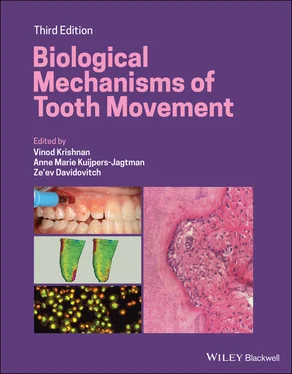17 Chapter 17Figure 17.1 Evidence supporting the biphasic theory of tooth movement. Rat h...Figure 17.2 Schematic of biphasic theory of tooth movement. The biologic res...Figure 17.3 Saturation of biological response with increased orthodontic for...Figure 17.4 MOPs accelerate tooth movement in rats. (a) Rat hemimaxilla show...Figure 17.5 MOPs accelerate canine retraction in a human clinical study. In ...Figure 17.6 MOPs reduce the density of alveolar bone changing the response t...Figure 17.7 Vibration in the form of high frequency acceleration (HFA) stimu...Figure 17.8 Vibration increases inflammatory markers and the number and acti...Figure 17.9 Harnessing inflammation to deliver precision‐accelerated tooth m...
18 Chapter 18Figure 18.1 Gingival enlargement associated with poorly executed orthodontic...Figure 18.2 The effect of poor placement of orthodontic bands. The first mol...Figure 18.3 Gingival recession associated with orthodontic treatment. (a) Re...Figure 18.4 Frequencies (%) of gingival recessions per tooth at four times: ...Figure 18.5 The effect of poor orthodontic mechanics: (a) the clinical pictu...Figure 18.6 The effect of improper orthodontic mechanics, which leads to can...Figure 18.7 The effect of faulty orthodontic mechanics, which led to uncontr...Figure 18.8 Enamel surface damage caused by various interproximal stripping ...Figure 18.9 Enamel decalcification areas associated with orthodontic banding...Figure 18.10 Surface damage resulting from various enamel clean‐up methods a...Figure 18.11 Energy dispersive spectrum (device used to characterize the opa...Figure 18.12 Extreme hyperreaction of the dental pulp after 40 months of ort...Figure 18.13 (a) A panoramic pretreatment radiograph of patient’s dentition ...Figure 18.14 Extreme hyperplastic reaction in the cheek mucosa caused by an ...
19 Chapter 19Figure 19.1 Relation between the total amount of experimental tooth movement...Figure 19.2 Individual data describing the relapse over time expressed as th...Figure 19.3 Individual data describing the relapse over time expressed as th...Figure 19.4 Pressure side of a dog premolar after relapse for 18 days. Loss ...Figure 19.5 Pressure side of a dog premolar after relapse for 18 days. Loss ...Figure 19.6 Pressure side of a dog premolar after relapse for 66 days. Local...Figure 19.7 Pressure side of a dog premolar after relapse for 90 days. Compl...Figure 19.8 Tension side of a dog premolar after relapse for 18 days. Recove...Figure 19.9 Tension side of a dog premolar after relapse for 18 days. Recove...Figure 19.10 Tension side of a dog premolar after relapse for 66 days. Norma...Figure 19.11 Tension side of a dog premolar after relapse for 66 days. Local...Figure 19.12 Tension side of a dog premolar after relapse for 90 days. Gener...
20 Chapter 20Figure 20.1 (a–f) A typodont is a training device consisting of artificial t...Figure 20.2 Media preparation of cell culture. In vitro studies require asep...Figure 20.3 Four phases of clinical trials in humans.Figure 20.4 Tissue section of a maxillary canine of a 1‐year‐old female cat,...Figure 20.5 Tissue section of alveolar bone of a 3‐month‐old kitten, 6 μm th...Figure 20.6 Inverted phase contrast fluorescent microscope involves the comb...Figure 20.7 Live/dead assay – application of fluorescent staining in cell re...Figure 20.8 Environmental scanning electron microscope (ESEM).Figure 20.9 A horizontal section, 6 μm thick, of a maxillary canine of a 1‐y...Figure 20.10 A view of the alveolar bone osteoblasts and adjacent PDL fibrob...Figure 20.11 Flow cytometry analysis of cell cycle. Flow cytometry offers a ...Figure 20.12 The steps in PCR.Figure 20.13 Western blot analysis of COX 2 (cyclooxygenase 2) expression in...Figure 20.14 MTT assay is considered to be the most accurate method for asse...Figure 20.15 Representative images obtained through comet assay. A, Control ...Figure 20.16 DNA fragmentation analysis: the experiment gives the opportunit...Figure 20.17 Experimental methods currently used for measuring mechanical pr...Figure 20.18 Representative image of a PDL fibroblast as observed under atom...Figure 20.19 Principle of laser deflection particle tracking. A particle at ...
21 Chapter 21Figure 21.1 Models for the relationship between force magnitude and the rate...Figure 21.2 Force–velocity curve calculated for human data derived from a ma...Figure 21.3 The cellular reactions related to the different stages of OTM....Figure 21.4 Transcriptional control of osteoblastic differentiation and prog...Figure 21.5 Theoretical model for tooth movement proposed by Henneman et al ....Figure 21.6 Schematic of sensors, signaling pathways, and responses involved...Figure 21.7 Real‐time RT‐PCR analysis of 10 genes differentially expressed i...Figure 21.8 Theoretical model of OTM from the systematic review of Vansant e ...Figure 21.9 Current and upcoming approaches to modulate OTM.
1 Cover
2 Table of Contents
3 Begin Reading
1 iii
2 iv
3 v
4 viii
5 ix
6 x
7 xi
8 xii
9 1
10 3
11 4
12 5
13 6
14 7
15 8
16 9
17 10
18 11
19 12
20 13
21 14
22 15
23 16
24 17
25 18
26 19
27 20
28 21
29 22
30 23
31 24
32 25
33 26
34 27
35 28
36 29
37 30
38 31
39 33
40 35
41 36
42 37
43 38
44 39
45 40
46 41
47 42
48 43
49 44
50 45
51 46
52 47
53 48
54 49
55 50
56 51
57 52
58 53
59 54
60 55
61 56
62 57
63 58
64 59
65 60
66 61
67 62
68 63
69 64
70 65
71 66
72 67
73 68
74 69
75 70
76 71
77 72
78 73
79 74
80 75
81 76
82 77
83 78
84 79
85 80
86 81
87 82
88 83
89 84
90 85
91 86
92 87
93 88
94 89
95 90
96 91
97 92
98 93
99 94
100 95
101 96
102 97
103 98
104 99
105 100
106 101
107 102
108 103
109 104
110 105
111 106
112 107
113 108
114 109
115 110
116 111
117 112
118 113
119 114
120 115
121 116
122 117
123 118
124 119
125 120
126 121
127 122
128 123
129 124
130 125
131 126
132 127
133 128
134 129
135 130
136 131
137 132
138 133
139 134
140 135
141 136
142 137
143 138
144 139
145 141
146 142
147 143
148 144
149 145
150 146
151 147
152 148
153 149
154 150
155 151
156 152
157 153
158 154
159 155
160 156
161 157
162 158
163 159
164 160
165 161
166 162
167 163
168 164
169 165
170 166
171 167
172 169
173 171
174 172
175 173
176 174
177 175
178 176
179 177
180 178
181 179
182 180
183 181
184 182
185 183
186 184
187 185
188 186
189 187
190 188
191 189
192 190
193 191
194 192
195 193
196 194
197 195
198 196
199 197
200 198
201 199
202 200
203 201
204 202
205 203
206 204
207 205
208 206
209 207
210 208
211 209
212 210
213 211
214 212
215 213
216 214
217 215
218 217
219 219
Читать дальше












